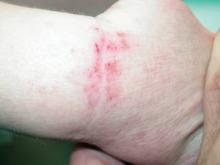The management of atopic dermatitis in children requires a comprehensive approach, as with any difficult chronic disease, according to Dr. Moise L. Levy.
"Atopic dermatitis [AD] is no different than any other chronic disease, including the psychosocial issues. It must be approached broadly. Whatever support the child and family need, you provide it," said Dr. Levy, chief of pediatric dermatology at Dell Children's Medical Center, Austin, Texas.
Ongoing education of the family about the importance of maintaining compliance with emollient and topical treatment is essential. Written "action plans" similar to those used with asthma patients can be helpful, Dr. Levy said at the annual Hawaii Dermatology Seminar sponsored by Skin Disease Education Foundation.
Recent evidence has highlighted the interaction between bacterial colonization - not active infection - and worsening of AD symptoms. Interleukins produced during active inflammation of AD appear to impair normal defenses against skin infection, he explained.
One study provides a rationale for the use of bleach baths in children with AD who are colonized with methicillin-resistant Staphylococcus aureus. Thirty-one children aged 6 months to 17 years with moderate to severe AD and clinical signs of bacterial infection received cephalexin for 2 weeks, then were randomized to intranasal mupirocin ointment and twice-weekly sodium hypochlorite baths (½ cup in 40 gallons) or a placebo of intranasal petrolatum plus plain water baths (Pediatrics 2009;123:e808-14).
Eczema Area and Severity Index (EASI) scores were improved at 1 and 3 months in the treatment arm, compared with the placebo group, in all submerged sites (not the head and neck), Dr. Levy reported.
Topical corticosteroids and calcineurin inhibitors can provide excellent control of moderate to severe AD flares, but data also suggest intermittent dosing may help prevent flares in the first place in patients with chronic relapsing disease.
In a two-phase study, 206 children aged 2-15 years with moderate to severe AD were randomized to aclometasone or tacrolimus for 4 days, and then received open-label tacrolimus twice daily for up to 16 weeks. After that, 105 children were randomized to application of either tacrolimus or a vehicle three times per week to clinically normal-appearing skin for up to 40 weeks.
The aclometasone group had better improvement during the acute phase, but there were no differences thereafter. In the long-term phase, the tacrolimus group had more disease-free days compared with the vehicle group, longer time to relapse, and fewer relapse days (Pediatrics 2008;122:e1210-8).
The use of systemic therapies should be reserved for children with the most severe AD, and considered only after aggressive topical therapy has been maximized and compliance with systemics can be ensured, Dr. Levy emphasized.
Currently, cyclosporine is the only one of these agents with sufficient pediatric efficacy and safety data to support its use in children with AD, and still must be used with caution. One pediatric study found that oral cyclosporine use in combination with topical corticosteroids was associated with greater loss of bone mass than was use of corticosteroids alone (Pediatr. Dermatol. 2007;24:613-20).
Although there is a large body of anecdotal evidence supporting the efficacy of other systemic agents such as mycophenolate mofetil, methotrexate, azathioprine, and thiopurine methyltransferase, at this time there are insufficient randomized, prospective clinical data in children with AD to support their use, he said.
The management of AD in children can be extremely challenging. At times, hospitalization and referral to a psychologist may be necessary to address the educational and psychosocial issues that prevent patients and families from maintaining long-term compliance.
One very helpful "treatment" is the American Academy of Dermatology's Camp Discovery (www.campdiscovery.org), where kids with chronic skin disorders can meet, share experiences, and feel "normal." All kids with AD should be offered the chance to go, Dr. Levy said.
Wrist with erythema, lichenification, and crusting (Photo Courtesy: Dr. Moise L. Levy)
He disclosed being on the advisory board of SkinMedica Inc. SDEF and this news organization are owned by Elsevier.


